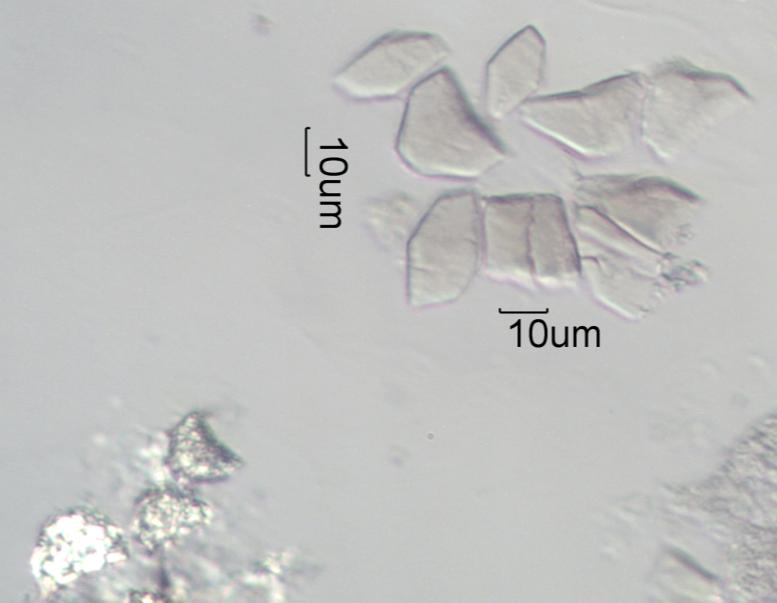Pyrolyzed Calcium Oxalate Phytolith
This is from an environmental tapelift collected outside a
home that was near a large Colorado wildfire.
The calcium oxalate phytoliths at upper right are still identifiable by their shape
but they have transformed as a result of the heat of the fire
into calcium oxide (CaO). The phytoliths at lower left still have many areas that
persist as calcium carbonate (CaCO4). The
calcium carbonate crystals are within the particle rather than on the outside. When
calcium carbonate forms on the outside it is the
result of the calcium oxide reacting with carbon dioxide and water in the air. The
shape of these phytoliths are consistent with deciduous
trees, such as Gambel and shrub live oak, and not conifers.
Transmitted Off Crossed Circular Polarized Light
Definition/Function:
Calcium oxalate phytoliths are present in two chemical forms and in many different
crystalline habits in plant material. The two chemical
forms are CaC2O4-H2O, whewellite, and
CaC2O4-H2O, weddellite. Calcium
oxalate phytoliths are exposed to high temperature, water vapor, and carbon dioxide in
the plume of a fire. Calcium oxalate converts
directly to microcrystalline calcite in the temperature range of 430 to 510 degrees
Celsius. If temperatures are higher then calcium oxalate will
convert to calcium oxide and then may react with water and carbon dioxide to form
calcium carbonate. All of these reactions are a function of
time at temperature. If the time is not sufficient at high enough temperature the
reaction may not be complete. The reactions begin at the
surface and move inward.
Significance in the Environment:
Characteristic Features:
Weddellite is an optically positive tetragonal crystal with refractive indices of 1.523
(w) and 1.544 (e), for a birefringence of 0.021.
Whewellite is an optically positive monoclinic crystal with refractive indices of 1.490
(a), 1.554 (b), and 1.650 (g), for a birefringence of
0.160. The pyrolysis products of both tend to be calcium carbonate. The calcium
carbonate poly-crystalline aggregate may retain the structure
of the original calcium oxalate crystal but the form of the individual calcium carbonate
crystals making up that shape may be as aragonite or
vaderite tablets or spherulites.
Associated Particles:
References:
http://univ-provence.academia.edu/JacquesBrochier/Papers/198408/Calcite_Crystals_Starch_Grains_Aggregates_or..._POCC_Comment_on_Calcite_Crystals_Inside_Archaeological_Plant_Tissues


